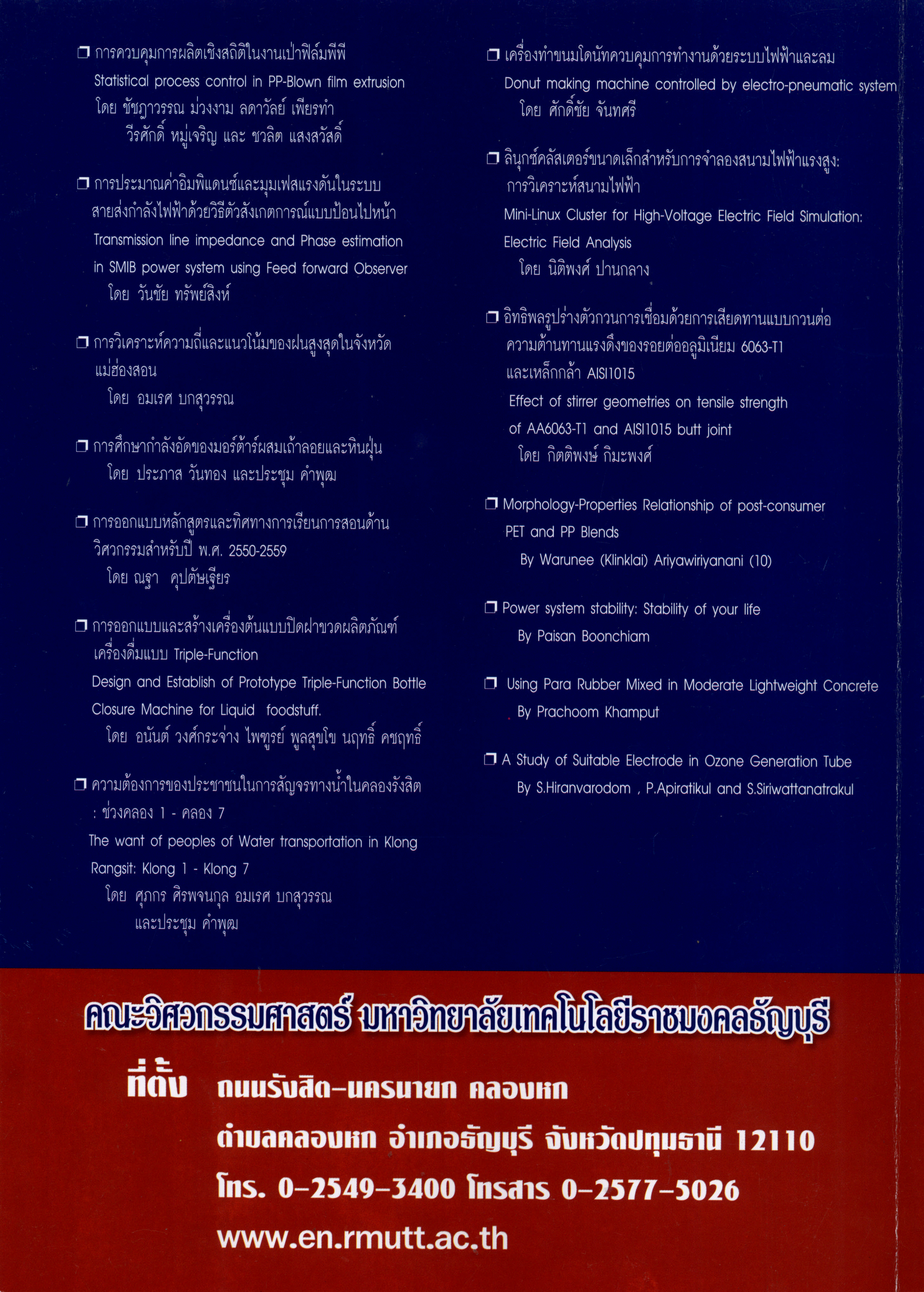Using para rubber mixed in moderate lightweight concrete
Main Article Content
Abstract
This research is to use latex from para-rubber as an admixture for improving the strength and insulation properties of autoclaved aerated lightweight comcrete. In mix design, cerment-send ratio is 1:1 (by weight). THe aluminum powder (3% by weight) is added, water-cement ratio is 0.5 (by weight not include water in latex), five percent of time and gypsum (by weight of cement) are added. To provide latex from para-rubber, the solution of ammonia at 15% of concentrdtion is added into para-rubber at amount of 3% (by weight of para-rubber). Concrete must be added 4% (by weight of cement) of the nonionic surfactant. The latex per cement ratios that use in this experiment are 0,0.10,0.15 and 0.20 (by weight of cement). THen mixing and streaming follow TIS ( Thailand Industrial Standard) and test the density by volume, compressoive and bending strength at ages of 3,7,14 and 28 days. The absorption of water is measured at 7 and 28 days, The elongation and coefficient of thermal conductivity are measured under ASTM standard. From the results, it is found that the compressive strength and density of lightweight concrete reverses variation with latex-cement ratios while the bending strength and water absorption of concrete is Propostion to latex-cement ratio. The elongation has an uncertainty for each latex-cement ratio. The coefficient of thermal conductivity is slightlg larger than normal lightweight concrete. the suitable latex-cement ratio is 0.10 (by weight of cement). By consider all of results, this can be produced as a moderate lightweight concrete in which high strength and good insulation are highlighted
Article Details
The manuscript, information, content, picture and so forth which were published on Frontiers in engineering innovation research has been a copyright of this journal only. There is not allow anyone or any organize to duplicate all content or some document for unethical publication.
References
Energy conservation encouragement office, Heat insulation, Department of Renewable Energy and Energy Conservation, Ministry of energy, http://www2.dede.go.th. (in thai)
A. Prugumphai, Handbook of para-rubber, Pet-plant publishing, 1" edition, Bangkok, 2547. (in thai)
Thailand Research Fund (TRF), Announcement for submitting small project of para-rubber, National project: division of para-rubber industry, 2548. (in thai)
V. Suwanprecha, Lightweight paracrete bricks,http://www.thailandrubber.thaigov.net, 2548. (in thai)
American Society for Testing and Materials, Standard Specification for Building Brick, ASTM C 62-69.,Philadelphia, 2001.
Thailand Industrial Standard, Industrial standard of portland cement vol. 1 quality specifications (TIS.15vol 1-2532), Bangkok, 2532. (in thai).
Thailand Industrial Standard, Industrial standard of limes (TIS 319-2541), Bangkok, 2541. (in thai)
Thailand Industrial Standard, Industrial standard of autoclaved aerated concrete (TIS. 1505-2541),
Bangkok, 2541. (in thai)
American Society for Testing and Materials, Standard Specification for Building Brick, ASTM C 62-69,Philadelphia, 2001.
American Society for Testing and Materials, ASTM C 177., Philadelphia, 2001.
P. Chindaprasert and C. Jaturaphitakkul, Cement,Pozzolan and Concrete, Siam Cement Industry
Co.Ltd., special edition, Bangkok, 2549. (in thai)
S. Chuajulrajit, Rubber technology, Department of material science, Faculty of science, Chulalongkorn University, Bangkok, 2548. (in thai)
Ohama, Y, Principle of Latex Modification on Some Typical Properties of Later-Modified Morty
and Concretes, ACI Materials Journal, Title No,44.M45, p 511-518, 1987.
Project of study the status of energy consumption and guide to encourage the conservative energy in houses, Characteristics and specifications of building materials, http://www.dede.go.th, 2549. (in thai)
C. Sattabhut, Concrete technology, Construction materials and products Co. Ltd., 5 th edition,
Bangkok, 2540. (in thai)

